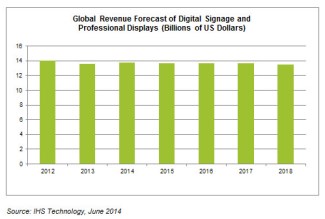
by Brianna Crandall — July 9, 2014—The digital signage industry is facing a formidable challenge from cheaper, conventional television panels that replace specialized custom products that long have differentiated the professional displays market, according to a new report from IHS Technology. Consisting of digital signage monitors and digital signage televisions used in venues such as hotels and public spaces, the signage and professional displays market will see global revenue start to deteriorate after this year unless the industry changes the current dynamics afflicting the space, says IHS.
Industry revenue in 2014 is forecast to reach $13.76 billion, an improvement over the 2013 sum of $13.58 billion but still down from the 2012 total of $14.00 billion. Moreover, none of the projected forecasts from 2015 to 2018 will exceed this year’s figure, as shown in the attached table, remaining flat despite a steady rise in shipments during the same time.
Signage advantages are many and distinct
Sanju Khatri, director of digital signage and professional video at HIS, explains the advantages of commercial digital signage. According to Khatri, the large-format displays used in digital signage are in the form of liquid-crystal display (LCD) panels designed specifically for commercial use. These LCD displays are built with commercial-grade panels for longer wear; enclosed in metal chassis for better heat dissipation; outfitted with special backlight modules for specific levels of brightness that enable them to show images clearly even in vivid indoor lighting; and some are loaded with media players, image sensors, touch modules and customized software or programming to show ads, information, promotions or entertainment fare expressly produced for the medium. Some displays also incorporate touch, gesture or embedded vision interfaces that interact with customers for added engagement.
Such carefully integrated features distinguish digital signage products from the conventional TVs available in normal retail outlets, says Khatri. The latter are intended for home use, and because their panels and electronic components are not designed for commercial use, conventional consumer TVs reportedly cannot cope with the rigorous 24/7 demands imposed on them when they are deployed in commercial settings. As a result, the consumer TVs wear out much more quickly while also failing to deliver on other fronts, such as clear viewing or targeted information meant to entice more sales for the establishment, adds Khatri.
In specific signage segments such as the command and control room, transportation or security, digital signage also adapts the panels for optimum use. For instance, multiple panels are often joined together to form a giant video wall. The signage panels in this case feature narrower bezels that can be less than 4 millimeters to make the image areas of the panels larger, with the overall effect of the video wall relatively seamless absent the distracting borders of the panels. Again, this is not possible with conventional TVs, Khatri adds.
Manifold challenges are in store for the industry
One problem for the industry is that commercial establishments forgo professional signage monitors, believing consumer-type TV sets to be useful alternatives. To establishment owners, however, the downside of using conventional TVs becomes apparent after about six months when the units are non-functional, says Khatri. End-users then lose money and become disillusioned, not realizing that professional signage displays could have averted the problem. Meanwhile, the signage industry gets maligned or becomes saddled with a bad reputation, further hindering signage prospects for both current and future customers. Khatri asserts that it is paramount for the industry to spend time educating buyers.
Another challenge for digital signage is that within the companies that make signage products, the division for signage may actually be in competition with the same company’s consumer TV segment, setting up the digital signage division for a loss.
Manufacturing efficiencies present a third challenge. As the cost to make panels continues to decrease and the panels become cheaper to sell, the industry needs to find other ways to compensate for the losses brought on by new competencies.
How the signage industry can boost sales prospects
The digital signage industry may still be able to turn things around, Khatri remarks. Digital signage panel manufacturers and set makers can capitalize on existing advantages offered by the technology. These include high-brightness displays of 1,000 to 1,500 nits without compromising display lifetimes; ultra-narrow bezel displays for data visualization; ultra-high-definition displays in high-end applications such as architecture firms and medical operating theaters; and touch, gesture or embedded vision for segments like education, for use in interactive whiteboards.
The retail market, for one, continues to be a sizable market opportunity, and the retail industry fully understands how digital signage contributes to an increase in sales, customer engagement and other benefits to consumers, points out Khatri. Here the signage industry can promote the technology to retail’s vast total available market, including supermarkets, discounters and warehouse clubs, department stores, quick-serve or fast-food restaurants, and convenience or even specialty stores.
Another solution calls for digital signage makers to partner with players in the larger ecosystem for signage, to come up with useful synergies that conventional TVs cannot hope to provide. For instance, display vendors could team up with other hardware and software vendors to provide smarter all-in-one units, capable of handling multiple sources of information, integration with mobile platforms, data analytics or real-time data integration for better targeted advertising or promotions.
These findings are available in the “Signage and Professional Displays Market Tracker—Q1 2014” report from the Consumer Electronics service of IHS.




